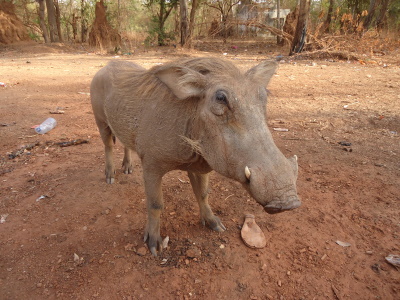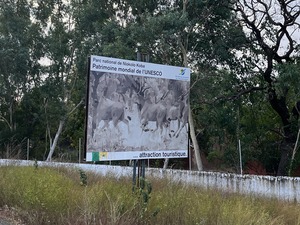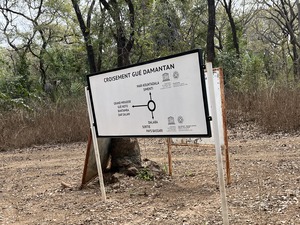Niokolo-Koba National Park

Niokolo-Koba National Park on the banks of the Gambia and other rivers is known for its diversity of wildlife.
Most of the park consists of relatively flat woodland savannah and semi-arid Sudanese forest, intermingled with wetlands. Wildlife, in numbers unique for this region, includes (at the time of inscription) elephants, lions, leopards, chimpanzees, baboons, hippopotamuses and the derby eland.
Community Perspective: The park was labelled “great” by our first reviewer, who visited in 2006 and 2008. More recently, however, the park has suffered from a severe loss in wildlife numbers due to poaching (IUCN Outlook 2020). Els in 2025 found it hard to reach areas with at least some animal activity.
Map of Niokolo-Koba National Park
Community Reviews
Els Slots

Like Bulgaria, Senegal was quick off the mark, resulting in some WHS getting in early which are questionable now. Niokolo-Koba, named after the Niokolo (Koba) River and the Kob antelope, is an enormous park in the east of the country. At its inscription it was rich in mammals including “a large population of elephants”, but after decades of poaching (which has been curtailed only in recent years), few of that is left. It has chimps, lions and other location-specific mammal species that are clinging on to existence and are heavily supported by conservation NGOs such as Panthera. Still, it’s remarkable considering the circumstances that such small and isolated populations have managed to survive for so long in West Africa.
Don’t expect to see them though, those elephants or lions which are so numerous in Southern and Eastern Africa – there are only a dozen or so here in a fairly inaccessible park. For a reality check, I recommend reading this trip report of someone who stayed in the park for 2 weeks in 2018 looking for wild dogs but saw none (no wild dogs, no lions, no elephants). Also, the park seems to leave the more interesting parts such as Mt Assirik to scientists only.
With my Gambian driver and guide, I stayed at Camp Wassadou, which lies just across the River Gambia from where the park begins. Some 20 other guests were present, which indicates that tourists still trickle in. On the afternoon of our arrival, we did a short boat ride on the river which wasn’t a success. It was even cut shorter as the engine failed after 20 minutes, so we had to paddle back. Some bee-eaters and green monkeys showed on the river banks.
The next day we were going for the full safari. You have to enter the main entrance at Dar Salam for that, bringing your own vehicle and having arranged for an obligatory park ranger to join you. Entrance fees have to be paid there as well. We did what turned out to be a 5.5-hour loop, since it takes at least 1.5 hours before you arrive somewhere (the Simenti area) with at least some animal activity. The drive there is on a rough, potholed sand track. This part mostly consists of forest, including an unexpected teak forest. Numerous termite mounds provided some additional colour – we saw one where small mongoose had made it into their home.
Our first mammal was an Oribi, a small antelope. Later on, in the more open areas of Simenti where there is a lake as well, the number of sightings became more frequent. I ended up with a mammal list of 10, including the flagship species Buffon's kob, and Roan antelope, Waterbuck and a Jackal. We saw 2 additional species near the lodge: Patas Monkeys and Western Red Colobus. The aforementioned visitor who stayed for 2 weeks saw ‘only’ 22 different mammal species. Unfortunately, I had not brought my superzoom camera on this trip, so I returned without good pictures of these animals although they were not skittish at all.
It was a long and in the end tiresome drive (as you have to drive another 1.5 hours to get out of the park again as well), bumpy, dusty, and hot. It surely isn’t worth it for the general tourist audience: my guide would advise his company to not include the park in any future itineraries and the word on the ground at Camp Wassadou also was “spare yourself the trouble”. I am glad that I went though, since there are very few comparable places in West Africa left and those are even harder to get into (like Pendjari in Benin or Comoé in Cote d’Ivoire).
Read more from Els Slots here.
Ben Potterton
Niokolokoba is a great reserve, I did'nt expect such a great range of species in Senegal. I have visited Simenti twice with West African Tours travelling from The Gambia once in 2006 and then again in 2008. On our second visit the species list included Leopard, Roan Antelope, Hippopotamus,Kob, Oribi, Waterbuck, Ground Hornbill, Black Crowned Crane, Saddle-billed Stork and Lion. We missed Hunting Dog and Chimpanzee (but we found fresh nests).
This park is a short / cheap flight from the UK and has great wildlife, some interesting villages and Simenti makes a great base.
Site Info
Site History
2024 Removed from Danger list
2007 In Danger
Critically low mammal populations, the ongoing management problems and the impacts of the proposed new dam on the Gambia river a few kilometres upstream of the park
1981 Inscribed
Site Links
Unesco Website
Official Website
Related
In the News
Connections
The site has 28 connections
Damaged
Ecology
Geography
Human Activity
Trivia
Visiting conditions
WHS Names
WHS on Other Lists
World Heritage Process
Visitors
30 Community Members have visited.
The Plaque
 (photo by Els)
(photo by Els) (photo by Els)
(photo by Els)